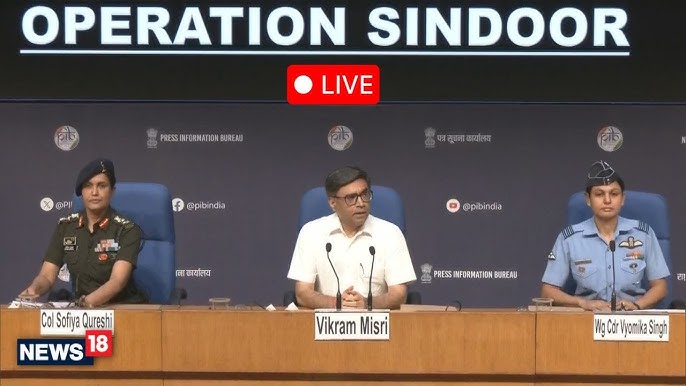
- Post the April 22nd terrorist attack in Pahalgam, the Indian government was keen to retaliate militarily against Pakistan.
- The Indian government, in its press briefing, confirmed that the Pakistani air defence system over Lahore had been completely neutralised.
- There have been concerted diplomatic efforts made by India to inform other countries about Pakistan’s violations and acts of terror.
- The events of the last 2 days clearly show that India’s air defence systems are far competent than Pakistan’s, and possibly more effective than China’s.
Post the April 22nd terrorist attack, the Indian government was keen to retaliate militarily against Pakistan. Finally, the military retaliation took place at midnight on May 7 under Operation Sindoor. The Indian defence forces targeted terrorist infrastructures across the eastern boundaries of Pakistan, mainly the sites that are close to the Line of Control. It is important to understand that all of those military sites were terrorist sites, and no civilians or Pakistani military infrastructures were targeted. Hence, it was a non-escalatory move carried out by the Indian Armed Forces.
For this operation, the Indian Armed Forces used SCALP EG missiles, and the Indian Air Force’s Rafale aircraft were also included in the attack. The specific locations that were targeted by the Indian forces include:
- Bahawalpur: Identified as the stronghold of Jaish-e-Mohammed, this area reportedly housed key operational facilities related to the terrorist organisation.
- Muridke: Considered the headquarters of Lashkar-e-Taiba, it was targeted due to its significance in militant activities. It is believed that almost 10 family members of Masood Azhar were killed in the attack.
- Gulpur, Bhimber, Chak Amru, Bagh, Kotli, Sialkot, and Muzaffarabad were the other prominent terror sites that were targeted by Indian defence forces.
All of these sites were harbouring terrorists and were among the largest hubs for terrorist activities. It is important to understand that all the choices made by the Indian government were well-calculated and strategic, and the operation was carried out in a very professional manner. No damage has been reported to the Indian military infrastructure involved in the attack.
By no means was this an initiation of war by the Indian government. Rather, it was a retaliation for the state-sponsored terrorist attack that Pakistan conducted against India on April 22 through its proxies. However, there are no definite casualty figures available, but in the all-party meeting conducted by Defence Minister Rajnath Singh on May 8, it was stated that over 100 terrorists had been killed. Given the infrastructure that was targeted, it appears that the number of terrorists killed is likely higher.
Pakistan’s Warmongering Gets a Befitting Response
In response to India’s Operation Sindoor, on May 8, Pakistan targeted 16 military and several civilian sites in several parts of the country with missiles and drones. The areas included Kupwara in Jammu, Amritsar, and Jalandhar. However, due to India’s strong air defence systems, no significant damage was reported, and all attempts were neutralised.
In a resolute action on the morning of May 8, the Indian government used Israeli-made IAI Harop kamikaze drones to target areas including Lahore, Rawalpindi, Sialkot, and Karachi. The Indian government, in its press briefing, confirmed that the Pakistani air defence system over Lahore had been completely neutralised.
It is to be noted that there is a clear difference between India’s retaliation and Pakistan’s counterattack. As stated by Foreign Secretary Mr. Vikram Misri, all Indian strikes were in response to the terrorist attack conducted by Pakistan. In contrast, Pakistan’s attacks have targeted civilian and military infrastructure in India, which is an act of war. India has only targeted terrorist infrastructure in Pakistan.

The Indian government has stated that it does not want to escalate the conflict, but if there are further violations by Pakistan, India will firmly respond to every attack. This has been echoed by various military chiefs and political leaders in India.
There have also been diplomatic efforts made, particularly by India, to inform other countries about Pakistan’s acts of terrorism. As soon as Operation Sindoor was conducted, India informed countries like the United States, the United Kingdom, the United Arab Emirates, Saudi Arabia, and Russia. Efforts have also been made by Saudi Arabia and Iran. The Saudi Arabian Foreign Minister visited India and had talks with the Indian Foreign Minister on May 8. Similarly, the Iranian Foreign Minister, who had earlier visited Pakistan, also came to India on May 8 and met with the Indian Foreign Minister.
As of now, none of the diplomatic efforts to end the conflict have succeeded. Terrorism cannot be justified, and diplomacy is only relevant when there are political differences. When a country commits acts of terrorism against another, diplomacy takes a backseat. At present, the situation between India and Pakistan is only escalating. Looking at the repeated provocations and continuous violations by Pakistan, it appears that further Indian retaliation may come in response to Pakistan’s actions.
Lessons for India
Amid all of this, there are great military lessons that India can take. In contemporary geopolitics, war has become inevitable, but war also provides lessons and teachings for every country. We have seen in the Russia-Ukraine war that Russia has understood its lessons and incorporated them. One of the outcomes of these lessons was the development of the new tactical weapon system called the Oreshnik missile.
The same can be seen in the case of Iran, where recently they unveiled the Qassem ballistic missile, which, according to Iranian claims, can penetrate Israel’s Iron Dome defence system. This was only made possible because Iran engaged in active conflict with Israel in Operation True Promise I and True Promise II, which occurred in April and May of 2024.
Similarly, India should also draw certain lessons from this context. One of the biggest lessons the Indian government can take is a deeper understanding of the Pakistani air defence system. The air defence system of Pakistan has proven to be highly incompetent. The HQ air defence systems that Pakistan uses have failed to intercept either the Indian missiles or the drone attacks.
India can take significant lessons from this and incorporate them into its military infrastructure. These lessons will not only help India in its western frontier but also its eastern frontier, particularly in its conflict with China, because China also uses HQ-series air defence systems.
A comparison can be made between the Indian and Pakistani air defence systems. Whenever India has retaliated against Pakistan, the majority of India’s targets have been hit successfully. In contrast, whenever Pakistan has launched missiles and drones at India, they have all been intercepted by India’s S-400 and Akash air defence systems. This clearly shows that India’s air defence systems are far stronger than Pakistan’s, and possibly even more effective than China’s.
References:
- https://www.ndtv.com/india-news/read-indias-full-statement-on-neutralising-pak-air-defence-radars-8361945
- https://timesofindia.indiatimes.com/india/pakistans-missile-drone-attack-foiled-how-indias-s-400-sudarshan-chakra-works/articleshow/121019632.cms
Aayush Pal is a freelance writer on contemporary geopolitical developments. The views expressed in his work are entirely his own.
